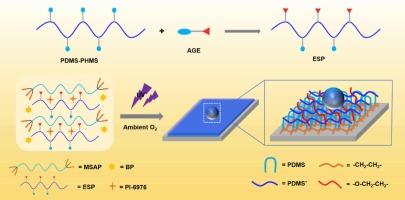Preparation of free radical/cationic hybrid UV-cured silicone materials with reducing oxygen inhibition via silyl radicals
IF 5.8
2区 化学
Q1 POLYMER SCIENCE
引用次数: 0
Abstract
UV-curing technology is a new, green technology with the advantages of being efficient, energy-saving, and environmentally friendly; however, there is a general oxygen-inhibition problem during the UV-curing process, especially when silicone acrylates are applied to the UV-curing treatment. Herein, epoxy-based silicone prepolymers (ESP) containing Si-H bonds were prepared through the hydrosilylation reaction of poly(dimethylsiloxane-co-methylhydrosiloxane) (PDMS-PHMS) and allyl glycidyl ether (AGE) to graft epoxy groups onto silicone segments while retaining part of the Si-H bond. The epoxy groups in the prepolymers are capable of cationic photopolymerization, and the retained Si-H bonds in the prepolymers can generate highly reactive silyl radicals for initiating free-radical photopolymerization. The anti-oxygen inhibition ability of silicone acrylates was enhanced with the addition of ESPs. Through experimental investigation, it was found that ESP-3 grafted with 0.30% epoxy groups had the best effect on reducing oxygen inhibition, and the silicone acrylates were able to undergo UV curing in air without sticky surfaces when the added amounts of ESP-3 were at 20 wt%. The addition of ESP-3 has no major impact on the transparency and thermal performance of the UV-cured coatings and further enhances their hydrophobic properties. The free radical/cationic hybrid UV-cured silicone materials reduce the problem of oxygen inhibition, and the UV-cured silicone materials have great potential as hydrophobic and self-cleaning materials.

制备通过硅基抑制还原氧的自由基/阳离子混合紫外线固化硅材料
紫外固化技术是一种新型绿色技术,具有高效、节能、环保等优点,但在紫外固化过程中普遍存在氧抑制问题,尤其是在应用硅丙烯酸酯进行紫外固化处理时。本文通过聚(二甲基硅氧烷-共甲基氢硅氧烷)(PDMS-PHMS)和烯丙基缩水甘油醚(AGE)的氢硅烷化反应,将环氧基团接枝到有机硅片段上,同时保留部分 Si-H 键,从而制备出含有 Si-H 键的环氧基有机硅预聚合物(ESP)。预聚物中的环氧基团可进行阳离子光聚合,而预聚物中保留的 Si-H 键可产生高活性硅基自由基,从而引发自由基光聚合反应。添加静电除尘器后,有机硅丙烯酸酯的抗氧抑制能力得到增强。通过实验研究发现,接枝了 0.30% 环氧基团的 ESP-3 对减少氧抑制的效果最好,当 ESP-3 的添加量为 20 wt% 时,有机硅丙烯酸酯能够在空气中进行紫外固化,且不会出现表面发粘的现象。添加 ESP-3 对紫外线固化涂层的透明度和热性能没有重大影响,并能进一步增强其疏水性能。自由基/阳离子混合紫外固化有机硅材料减少了氧抑制问题,紫外固化有机硅材料作为疏水和自清洁材料具有很大的潜力。
本文章由计算机程序翻译,如有差异,请以英文原文为准。
求助全文
约1分钟内获得全文
求助全文
来源期刊

European Polymer Journal
化学-高分子科学
CiteScore
9.90
自引率
10.00%
发文量
691
审稿时长
23 days
期刊介绍:
European Polymer Journal is dedicated to publishing work on fundamental and applied polymer chemistry and macromolecular materials. The journal covers all aspects of polymer synthesis, including polymerization mechanisms and chemical functional transformations, with a focus on novel polymers and the relationships between molecular structure and polymer properties. In addition, we welcome submissions on bio-based or renewable polymers, stimuli-responsive systems and polymer bio-hybrids. European Polymer Journal also publishes research on the biomedical application of polymers, including drug delivery and regenerative medicine. The main scope is covered but not limited to the following core research areas:
Polymer synthesis and functionalization
• Novel synthetic routes for polymerization, functional modification, controlled/living polymerization and precision polymers.
Stimuli-responsive polymers
• Including shape memory and self-healing polymers.
Supramolecular polymers and self-assembly
• Molecular recognition and higher order polymer structures.
Renewable and sustainable polymers
• Bio-based, biodegradable and anti-microbial polymers and polymeric bio-nanocomposites.
Polymers at interfaces and surfaces
• Chemistry and engineering of surfaces with biological relevance, including patterning, antifouling polymers and polymers for membrane applications.
Biomedical applications and nanomedicine
• Polymers for regenerative medicine, drug delivery molecular release and gene therapy
The scope of European Polymer Journal no longer includes Polymer Physics.
 求助内容:
求助内容: 应助结果提醒方式:
应助结果提醒方式:


